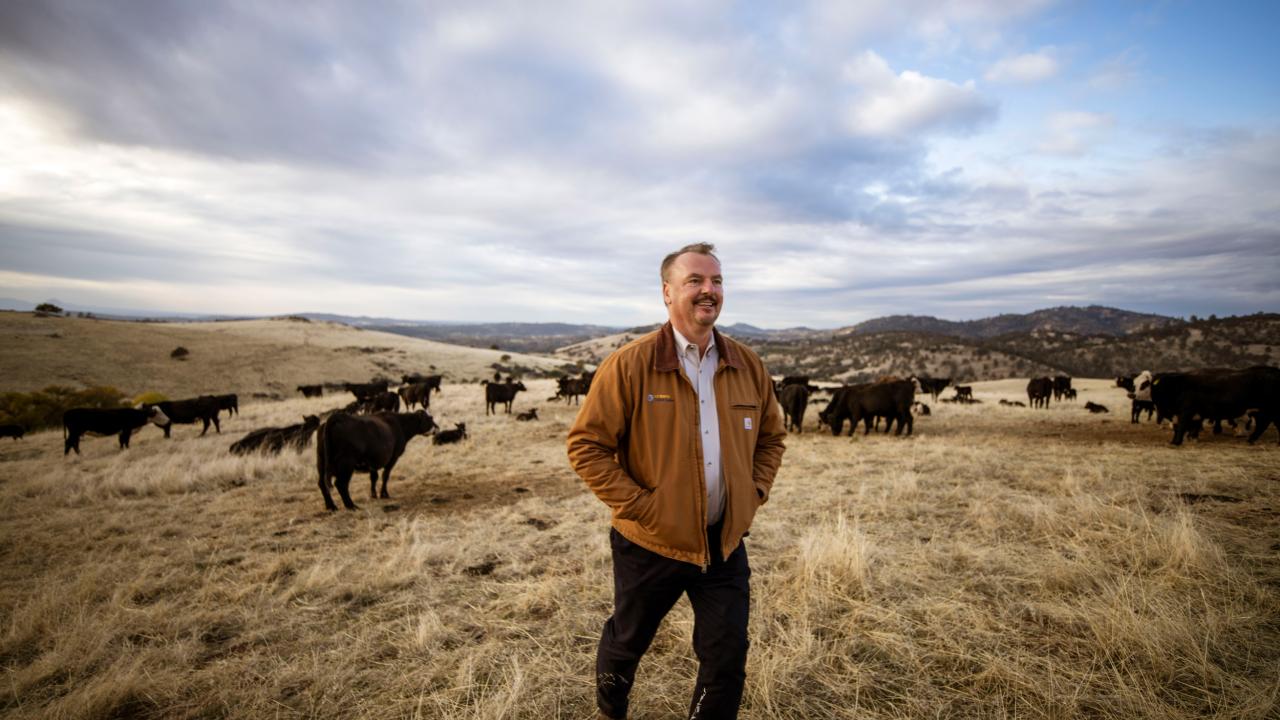
CLEAR Center Director Frank Mitloehner and Lab Awarded two CDFA Grants
CLEAR Center will investigate longterm treatment of Bovaer and early-life intervention in cattle to reduce enteric methane emissions
This news release is based on information communicated by the CDFA.
DAVIS, California, Dec. 23, 2023 – The California Department of Food and Agriculture's Office of Environmental Farming and Innovation (OEFI) has announced the award of $9.2 million in grant funding for six research projects under the Livestock Enteric Methane Emission Reduction Research Program (LEMER-RP). These funds, allocated by the Budget Act of 2022, will support research that evaluates additives and dietary modifications shown to reduce enteric methane emissions in the dairy and livestock sectors.
Frank Mitloehner, a professor of animal agriculture and air quality at the University of California, Davis and director of the university’s CLEAR Center, received two awards totaling nearly $4 million. He will use the funding in his lab to undertake studies of the long-term efficacy of the feed additive Bovaer, also referred to as 3-NOP, on California dairy cows. His team also will venture into somewhat uncharted research waters, investigating the impact of modifying microbes in the rumen – the source of methane-producing cattle burps – before it is fully formed by introducing a feed additive early in the animal’s life.
CDFA Secretary Karen Ross expressed her enthusiasm over the state’s funding, drawing a parallel between California’s recent focus on alternative manure management and this latest venture surrounding enteric methane emissions.
“California has been working for years in partnership with dairy producers to decrease methane emissions from manure storage. We’ve created a successful model that has made it feasible for dairy farmers to install anaerobic digesters and adopt other alternative manure management practices,” she said. “We’re fortunate in this state to have legal and budgetary support from Governor Newsom to bolster those efforts and develop a workable plan to reduce enteric methane emissions.”
Enteric methane emissions – otherwise known as methane belches – occur naturally in ruminant animals such as cattle, goats and sheep, during the digestion of their food. Microbes in the specialized stomach known as the rumen produce methane in the process of breaking down cellulose. The animals then emit a large amount of methane through belching. In fact, enteric emissions are the No. 1 source of methane emissions from livestock.
In 2020, dairy and livestock enteric methane emissions accounted for more than 11 million metric tons of carbon dioxide equivalent (MMTCO2e) emissions per year in California, representing 35% of the state’s agriculture and forestry sector greenhouse gases. Because methane is a potent greenhouse gas with 25 to 28 times the warming potential of carbon dioxide in the first 10 years after it’s emitted, it is critical to develop a tool kit of ways to reduce emissions in order to curtail global warming and safeguard the global food supply chain.
“It’s exciting to see California make such a major commitment to fund research aimed at reducing enteric emissions from cattle,” Mitloehner said. “There are so many exciting projects in the LEMER-RP program, and I’m thrilled my team will be able to look at two of them at a time when this work has never been more important.”
Mitloehner plans to partner with producers during his studies, which has long been his approach to finding workable sustainability solutions. It’s a model endorsed by many, including Vrashabh Kapate, manager of dairy industry at Environmental Defense Fund.
“Understanding the needs and challenges of farmers is crucial because these solutions have to be deployed at the farm,” he said. “We hope the LEMER-RP research funding will help identify safe, effective and practical strategies to bring products to market that will benefit both the environment and farmers.”
That’s music to Mitloehner’s ears as he readies to roll up his sleeves and get to work.
Each awardee will conduct research based on four impact areas developed during a science summit in May 2023, ensuring a comprehensive and targeted approach to addressing this pressing environmental issue. For example, one funded project will consist of giving dairy cows a 3-Nitrooxypropanol (3-NOP) feed additive for one or more lactation cycles, followed by an evaluation of its effect on reducing enteric methane emissions.
“The research funding for enteric methane reduction in LEMER-RP will continue to ensure science is supporting innovation as the dairy industry continues to expeditiously reduce our environmental footprint,” said Darrin Monteiro, vice president of sustainability and member relations at California Dairies, Inc.
Other UC Davis-associated researchers receiving grants include Noelia Silva del Rio, an associate specialist in cooperative extension and veterinary medicine; and a team from the University of California Cooperative Extension that includes Gabriele Maier, assistant professor in cooperative extension for beef cattle herd health and production at UC Davis School of Veterinary Medicine.
The complete list of grant awardees and project descriptions can be found on the LEMER-RP website at https://www.cdfa.ca.gov/oefi/enteric/.
LEMER-RP is part of California Climate Investments (CCI), a statewide program that puts billions of Cap-and-Trade dollars to work reducing greenhouse gas emissions, strengthening the economy, and improving public health and the environment– particularly in disadvantaged communities. The Cap-and-Trade program also creates a financial incentive for industries to invest in clean technologies and develop innovative ways to reduce pollution. CCI projects include affordable housing, renewable energy, public transportation, zero-emission vehicles, environmental restoration, more sustainable agriculture, recycling, and much more. At least 35 percent of these investments are located within and benefiting residents of disadvantaged communities, low-income communities, and low-income households across California. For more information, please visit the CCI website at: https://www.caclimateinvestments.ca.gov/cci-about.
Media Resources
For any inquiries regarding the LEMER-RP program, please email CDFA.OEFI_Enteric_Methane_Reduction@cdfa.ca.gov.
For inquiries to the CLEAR Center, please email Joe Proudman at jproudman@ucdavis.edu.
